
69 minute read
Mill Memories: Recollections of Ashby's Mill, Brixton
Welcome to Mill Memories, a collection of stories and recollections of Brixton residents and their families who have lived and worked around the windmill. When Brixton Windmill reopened to the public in 2011 after its most recent restoration, the Friends of Windmill Gardens started receiving letters and emails from people as far afield as Australia, who had heard about the restoration and got in touch with their memories of the building. Then in 2012 we successfully bid for money from the Heritage Lottery Fund All Our Stories programme to explore, share and celebrate people’s heritage. The result is this book, along with an exhibition and performance, based on interviews with 26 people about their connections to Brixton Windmill. Brixton Windmill will be 200 years old in 2016 – we hope you enjoy celebrating its history by sharing the memories of the interviewees here! Friends of Windmill Gardens
May 2014
Advertisement
A brick tower windmill 1816 1827 1845 1864 1902 1817 1844 1862 1890s is built to the west of Brixton Hill on open farm land John Ashby, miller, signs a 99-year lease for the land and windmill Two of the windmill’s common sails are changed to patent (shuttered) sails – much easier to operate John Ashby allows seven new houses to be built on part of his land. Over the following years Brixton Hill becomes more built up and this affects the flow of wind John dies. His will states that either of his sons, Aaron or Joshua, should continue the milling business at Brixton Because of lack of wind the Ashbys transfer milling to Mitcham, signing a 40-year lease on watermills on the Ashby & Sons, Millers, Corn & Forage Merchants The family remove Brixton Windmill’s sails and use the brick tower for storage The watermill lease expires. The Ashbys move back to Brixton, installing a modern steam-powered modular mill inside the tower to produce stone-ground flour and wheat meal River Wandle of Brixton Hill and Wandle Mills, Mitcham, advertise that their vans ‘call on residents in the vicinity to deliver…Fine wheat meal for brown bread’ World War II: fortunately Brixton The fully restored 1939-45 1957 1968 1990s 1934 1951 1963 1984-85 Windmill survives the bombing of London The LCC finally buy the site and work starts on laying out gardens around the mill windmill opens to the public each summer weekend, but in the mid ’70s the mill falls into a cycle of restoration and refurbishment followed by vandalism and neglect Vandalised once again, Brixton Windmill is closed to the public The government list the mill as Grade II*. Lambeth Borough Council decide to buy the mill but ask London County Council (LCC) for financial help Joshua Ashby, grandson of the first miller at Brixton, closes the business. Lambeth Borough Council approach the Society for the Protection of Ancient Buildings about preserving the mill. The following May Joshua, who never married, dies aged 77 Millwright R Thompson begins to restore the mill. Some wind machinery is brought from a derelict tower mill in Lincolnshire and new Major restoration by millwright David Nicholls includes making a new set of sails sails are made


Friends of Windmill Gardens 2003 2010 2012 2002 2007 2011 2016 The HLF award a generous grant to pay for the restoration of Brixton Windmill. With money from Lambeth Council and FoWG it also funds a 5-year windmill schools programme, regular windmill maintenance, and opening the building in summer months for free public visits FoWG win the national Museum+Heritage Award for conservation and restoration A partnership is signed between FoWG and Lambeth Council to raise money to restore Brixton Windmill. Several applications are made to the Heritage Lottery Fund (HLF) May: 2,000 Brixton people celebrate the restoration of Brixton Windmill, joining FoWG’s parade Brixton Windmill, also (FoWG) are set up to restore and re-open Brixton Windmill, improve Windmill Gardens and open a Windmill education centre. They begin a programme of annual free festivals and other community events Brixton Windmill is placed on English Heritage’s Buildings at Risk register and festival. September: known locally as Lower the windmill is regularly Mill Brixton or Ashby’s opened to the public Mill, will celebrate its 200th anniversary

06 Brixton’s hidden gem 10 the AshBy fAmily the working mill growing up Around the mill windmill Becomes derelict in the 1970s restorAtion in the 1980s Another period of neglect in the 1990s formAtion of fowg And eArly Activities Applying for money to restore the mill restorAtion in 2010-2011 14 18 24 26 30 34 38 40 mAy dAy pArAde 2011 importAnce of flour And BreAd production Bringing the community together 44 46 54 58 the future
Brixton’s hidden gem
Did you know that Brixton has a windmill? Many people don’t, even when they live nearby!

Iain Boulton Iain is currently the Parks Project Officer (Communities and Education) at Lambeth Council. He is a longstanding supporter of the Friends of Windmill Gardens I thought, ‘What’s a windmill doing in Brixton?’ I knew what windmills were, but I thought, ‘Where?!’...my boss at the time...was doing a project on...the regeneration of Clapham Park Estate, and he said, ‘Do you want to have a look at this?’ So we walked past Brixton Prison, and I thought, ‘That’s not a windmill’, and turned up and, hey presto, we came through the Blenheim Gardens Estate and there was a windmill. And I went, ‘No, it’s a windmill!’. It’s sort of happenchance – finding a windmill in a place like Brixton. You know, grimy, built up, highly populated south London with a history of this, that and the other. There’s suddenly a windmill there. The last thing you would have thought of. And you just say ‘windmill in Brixton’ and everybody’s face lights up at the thought. And I think that’s part of the reason why everybody is supportive of it. It’s such a lovely idea having a windmill here.Adrian Garden Adrian moved to Brixton in 2001 and is a former chair of the Friends of Windmill Gardens
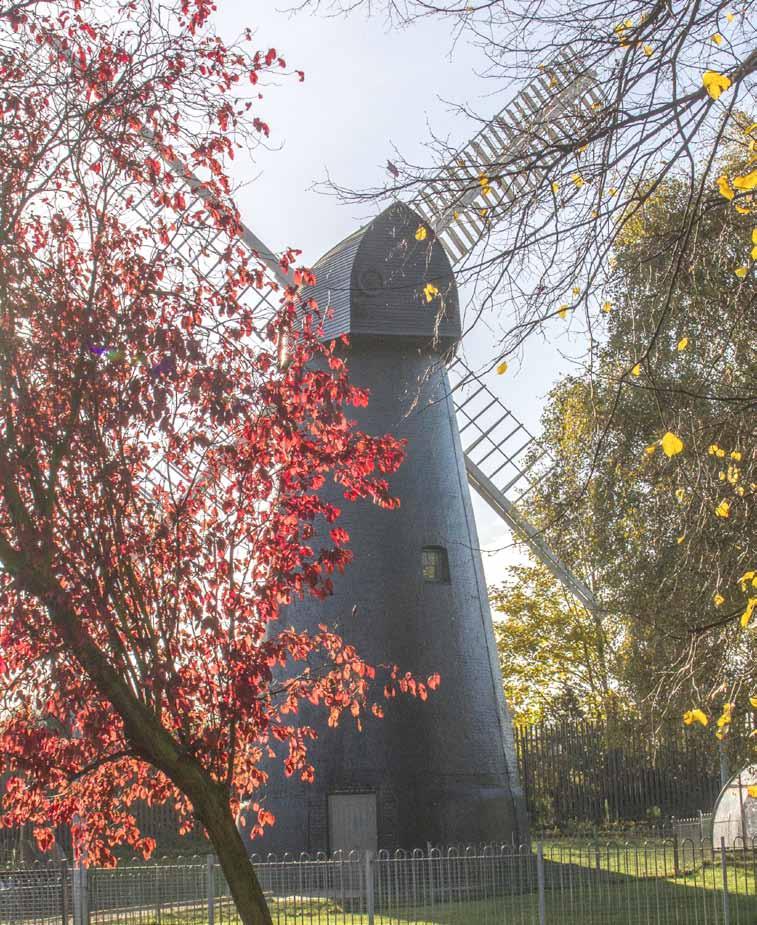
Brixton Windmill sits at the back of Windmill Gardens, just off Brixton Hill. As it’s hidden from view by surrounding buildings and trees, you see it only when you enter the small park
I had been living in the Brixton London area for about four years before I...joined the staff at HMP Brixton. I wasn’t still aware – I was parking on the avenue, going into work for maybe two years before I realised there was anything here. And then one night I was on night duty and I climbed the stairs and there was a very bright moon and I just looked out and I couldn’t believe what I saw. I saw that windmill. And I remember going straight down the stairs and saying ‘Did you realise there’s a windmill, a real windmill? Or is it
8 Kate Quigley Ruby Kate worked at HMP Brixton in the 1990s an ornament in somebody’s garden I’m seeing that’s actually big?’ And some of the other people I work with said, ‘No, it’s for real and it’s one of the great gems that Brixton has hidden away.’ About 30 years ago when I was a student nurse we were taken to Brixton Prison to go around the psychiatric unit and see what was happening. I just happened to look out of the window on one of the staircases and I saw the windmill. So I was talking to my mum one day and I said, ‘I didn’t realise there was a windmill in Brixton’, and she said, ‘That’s where your grandad worked.’ Brixton Windmill, built in 1816, seen from a window of Brixton Prison, built in 1819. The grassed area between the two buildings is a covered reservoir
Susan Young Susan Young’s grandfather worked at Brixton Windmill in the early 20th centuryBrixton Windmill does mean a lot. I’ve lived in Lambeth for 55 years. I’m glad it’s now getting noticed because when you come along Brixton Hill, you don’t really see much that says ‘This way to the windmill’. I think they’ve got a little notice, because it’s tucked away! ...It does mean a lot because it brings the community together.

June Stillman June has lived in Brixton for 55 years and is a longstanding supporter of the windmill
John Thorpe John is a descendant of John Ashby, the first owner of Brixton Windmill I couldn’t even see it to begin with and then suddenly it’s there…in all its splendour…In a funny sort of way one of the things is it actually looks a bit smaller than I would have expected. But on the other hand having been all the way round it I realised that they did pack a lot into a very small space...
the AshBy fAmily Also known as Ashby’s Mill, Brixton Windmill was operated by the Ashby family for whole of its working life, from 1817 to 1934.

John AshBy
miller 1807 - 1849 In the mid-1850s, John built Croydon Mill and founded the firm of Ashby Son & Allen steam millers at St James Road, Croydon chArlotte giBBArd hAnnAh AshBy AAron AshBy
miller 1811 - 1854 elizABeth tAylor
1809 - 1885
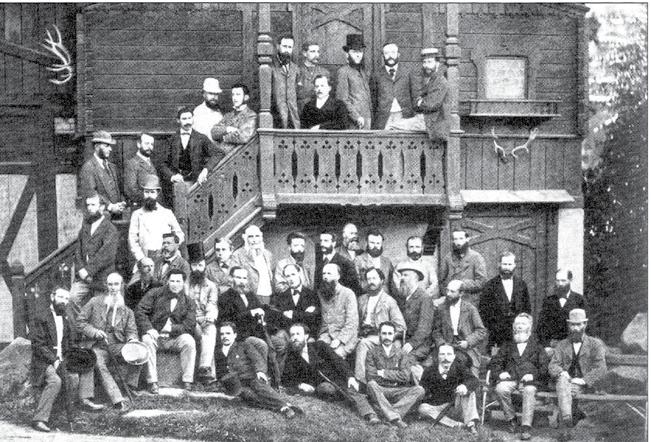
frederick AshBy mAry hAnnAh AshBy John AshBy Arthur AshBy frAncis AshBy
1842 - ? Great-grandfather of Henry Ashby, Viv Whittingham and John Thorpe
Francis Ashby, seated centre on balcony in black jacket, at the Vienna International Corn, Seed and Machinery Exhibition, 1897. Francis is the great grandfather of Henry Ashby, Viv Whittingham and John Thorpe, all interviewed in this book, who can trace their ancestry back to Brixton Windmill’s first miller John Ashby
Millers at Brixton Windmill
JuliA AshBy elizA AshBy John AshBy
miller 1772 - 1845
hAnnAh luetchford
1779 – after 1851
Amos AshBy JoshuA AshBy
miller 1821 - 1888 In 1862 Joshua moved the family business to Mitcham, where it stayed until 1902, when Joshua John returned the business to Brixton
mAry george
1829 - 1902 elizABeth Ann AshBy
chArlotte elizABeth AshBy henry AshBy thomAs JoshuA AshBy
edmund AshBy AAron frederick AshBy
ernest wAlter AshBy hAnnAh A AshBy BernArd gideon AshBy
miller 1856 - 1925 JoshuA John AshBy
miller 1858 - 1935 mAry Ann AshBy
Henry Ashby Henry is a descendant of John Ashby, the first owner of Brixton Windill I was just working out that John Ashby, who was a miller in 1803, he’s my... – one, two – fourth grandfather. Now John Ashby – his son, John – ran the mill and my great-great-grandfather was the eldest son of John Ashby. He in fact was also a miller but he had a chain of mills round south London. His brother was Joshua, who I think was the third son of John, and it was Joshua who inherited Brixton mill and he handed it down to his son Joshua who never married and eventually the property stopped milling, I think in the 1920s. The property on his death went to his housekeeper and she sold everything up and we don’t know what happened to that at all.

My grandmother’s father, Francis, was the last one...to stay a miller...I think he was quite successful. I don’t know why it hasn’t actually followed down the family, but he was a very active miller, and he went abroad finding out about new methods of rolling mills or something like that. So he was quite a go-getter I think. That was Francis. Who didn’t actually live here.
Viv Whittingham Viv is a descendant of John Ashby, the first owner of Brixton Windmill I imagine [life was] hard for the children as well, because as I said, they seemed to be really industrious. Not only did they have all these mills all over the place – because they’d been sort of millers and agricultural people in Sussex for generations and generations and generations. And the fortunes going up and down, up and down, up and down – maybe a farmer this generation, maybe a labourer, maybe a miller. And they seem to have been very busy, very full of the ‘Protestant work ethic’. And they were associated with a laundry and all kinds of enterprises.
Part of a 60-metre-long mural in the playground of Windmill Gardens, this poem records the members of the Ashby family who worked as millers at Brixton Windmill
the working mill

After 1902 Brixton Windmill was given a new lease of life, powered by steam and then gas rather than wind.



And of course, in their down time they would have done maintenance, perhaps painted the mill, painted the sails. There’s always something to do, which unfortunately doesn’t happen nowadays because a lot of the mills are, I’ll say, museum pieces. We restore them as best we can and we walk away and the whole process starts again, really.
There would have been a team of guys working in the mill. Obviously, the head miller would have been ensuring that the produce is as expected it should be. Then he would have had, perhaps, boys or young men on the dust floor loading the bins and people taking the ground flour out and loading onto wagons or trailers or whatever vehicle they had. It was a hive of activity.

Paul Sellwood Paul is Millwright Manager at Owlsworth IJP and was involved in the 2010 restoration of Brixton Windmill The only surviving photograph of Brixton Windmill before 1862, when the Ashby family moved their business to a watermill on the River Wandle at Mitcham

A young girl at Brixton Windmill in the early years of the 20th century. The Ashbys sold fresh eggs as well as flour at Brixton Windmill Advert promoting the Ashby business at Brixton Hill and at Wandle Mills in Mitcham. This pre-dates the family’s return to Brixton Hill in 1902




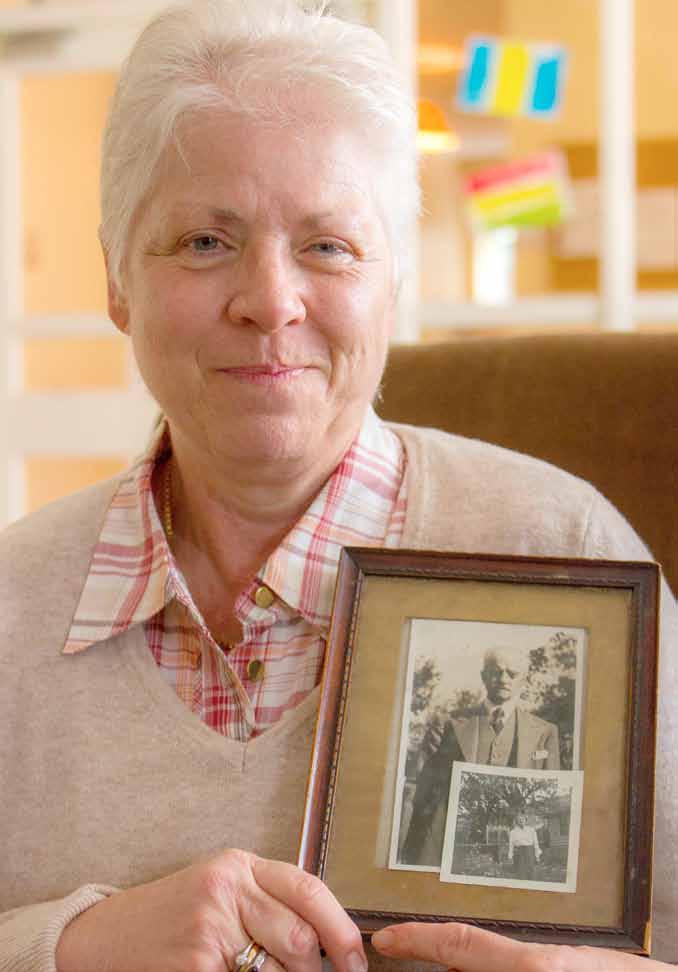
His parents, grandparents and great grandparents all the way down the line would all have been working in agriculture as labourers going back to the beginning of the 1800s and earlier. So he would have had a knowledge of wheat and flour. And the wives and children of those families would be quite often ‘platters’ or ‘platers’ and they make things out of the sheaves and bits of corn – that’s an income for a working family. So he would have had a good knowledge before he came to London or Brixton.
The 1911 census shows his brother Harry, two years older...it shows his occupation as journeyman to mill or miller’s journeyman...the address is...the same address as his younger brother shows on his marriage certificate six months later. And that certificate shows him as a warehouseman in flour mill. And there’s a third certificate and that shows grandad’s address at the same census in 1911 and that shows him...living with a family as a lodger or boarder and the head of that family is a Mr Neary and his occupation is a miller.
Sue Young’s grandfather worked at Brixton Mill at the time that Joshua John was the miller there Gilbert Young Gilbert Young is married to Susan Young, whose grandfather worked at Brixton Windmill in the early 20th century. He has done extensive research into Susan’s family history
growing up Around the mill Childhood memories of houses and shops in the area before the Blenheim Gardens Estate was built.
The windmill…as I grew up and as naughty children do climb the fence and go scrumping. We used to go home some days with loads and loads of apples, plums and blackberries…there used to be like a big wooden gate with barbed wire around it – we still used to climb over. That’s how I’ve got a scar that long on my leg...climbing the fence. The man that used to be in Edwards’s yard sees us, shouted – course we scarpered – run – went to go over the fence and as we did I scoured me leg open and run all the way home with me leg hanging open...The plums were beautiful and you just used to pick them and eat them and when you go home, the next day: ‘O-oh mum I’ve got belly ache’.Very much like Coronation Street houses. You came out… some had a little bit of garden – front garden. Some had none…On the corner of Vicary Street used to be a little grocery store. His name was Mr Vinton. He used to sell sweets. You could go in there and get one or two slices of bacon. One or two eggs – and he’d weigh sugar up in the bag. You’d take an empty bottle and get your vinegar from him – out of the barrel. Different things like that. The old fashioned way.
Joshua Ashby, the last miller at Brixton, was a keen botanist and kept a productive garden until his death in 1935. In the 1950s the abandoned garden was a great place to go scrumping …we used to have a fish and chip shop in the middle of Blenheim Gardens called Chaneys. We used to have a little bakers as you walked further down...I used to go in there in the mornings used to get these – what did we used to call them? Traffic lights. With green, red and yellow jam in. And they used to come out red hot in the mornings...on the corner of Tregenna Street you had a butchers called Sorrels. You had a newsagents Mr Hicks, who I used [to do a] to paper round for, and next door to him you had like another grocery World War II flying bomb damage in Dumbarton Road just south of Brixton Windmill. The horse-drawn cart in the centre advertises FW Stares (Bakers) of 59 Lyham Road store where you could go in if you only wanted two slices of corned beef which, in them days, I used to come up and get it with a note from me mum: ‘Two slices of corned beef please.’ That would do for dad’s sandwiches the next day. ...at the bottom of Tregenna Street we used to have a lady called Mrs Durkin. She used to lay out the dead and she’d always, every day be sitting…outside her front door she used to have like an old wooden fence bit and she used to sit on there in her full black dress, white apron and the white bit around her head. And she’d sit there. Anybody died – you went and got Mrs Durkin and she laid them out. Anybody going to have a baby you went and got Mrs Durkin – she delivered the baby…But seeing my mum a few weekends ago and she was saying: ‘Do you remember Mrs Durkin?’ I said ‘Yes.’ Everybody did. We used to call her the Old Witch – us kids were frightened of her...as you come round the corner from school she’d want you to go and run an errand for her. So we used to go round the other way. All quotes on these pages by Florence Hall Florence grew up in the area around Brixton Windmill in the 1950s 19

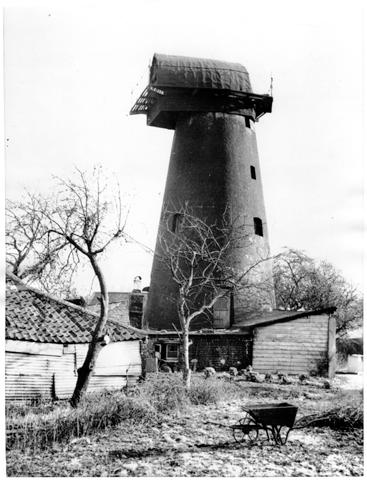
I was born in Tregenna Street and that was in 1932 on Christmas Day. Seven o’clock in the morning when it was thick with snow – as my father always used to tell me…We lived in a tiny two-bottom – twodown and two-up house. They were lovely little houses and it’s heartbreaking to see them all gone now. Lovely little garden that my grandfather thought the world of...there was all the family, my grandparents, about three or four aunts and uncle, my mum and my dad and myself Maureen Lemon’s brother and his friends pose in their Sunday best in the mill yard at Ashby’s Mill, Brixton and my brother and we all lived in that one little house. It was very crowded. I don’t remember an awful lot about it except that, as I say, it was very small. ...on the corner there was three shops and one was a butcher which was called Sorrel’s and one was a grocery store called Wayne’s.
Now Wayne’s had three daughters and I do believe – well I now think that these two girls in the picture are the Wayne’s children…and this is my brother who I think must have been about maybe seven or eight.
20 This young man – his name is Tony.
The popular Windmill pub on the corner of Blenheim Gardens and Bartley Street was much loved by Maureen Lemon’s father 21 All quotes on these pages by Maureen Lemon Maureen grew up in the area around Brixton Mill in the 1930s I do remember coming back to the Windmill pub quite often with my parents. Because my father he absolutely adored the Windmill pub. Whenever they used to come back from holidays the first thing he would do was drop the cases and say to my mum: ‘Come on. Let’s go up the Windmill.’ And I remember, many times at the Windmill pub they would have a man playing the accordion and it would be a singsong. Really lovely atmosphere. Lovely pub. And when I got married at the age of 22 the chappie who used to play the piano accordion, he came and played at my wedding. It was a very popular pub and a lot of people were upset when they decided to pull it down.



Grandparents and great-great-grandfather - they came from Bethnal Green and they opened a shop in Blenheim Gardens. Now apparently great-greatgrandad had a loom, so he worked in a back room of the shop...It must have been a food shop because I remember some years ago finding a receipt for 500 hens’ eggs and it was about £20-£25.




This corndealer and confectioner’s on Cornwall Road (now Blenheim Gardens) was typical of the many local shops in the streets around Brixton Windmill
Looking north down Lyham Road, where Robert Burns lived during World War II Prague Street, typical of the Victorian terraces near the windmill where Florence Hall and Maureen Lemon grew up. In 1968 these houses were about to be demolished to make way for the new Blenheim Gardens Estate 23 All quotes on these pages by Robert Burns Robert was born in 1932 and has lived in Brixton all his life ...we came back to Lyham Road...that would probably be late ’42, maybe ’43. And we’d only been here for a short time and they think an aircraft was meandering on its way back to base and it had two bombs on them, and they dropped them in Lyham Road... One was on the corner of Kildoran Road, where the little park is, and the other one was on the other side of the road, where the flats now stand, they were completely wiped out at the whole of that point, that was flat. And then they patched us up, and come the middle of June, after the D-Day landings, a doodlebug dropped in Ellerslie Square, more or less wiped that out completely.
windmill BeComes dereliCt in the 1970s After restoration in 1964, when machinery from a Lincolnshire mill was installed, the mill opened to the public but had fallen into neglect again by the mid ’70s.


I came to England in 1962 and moved to Brixton in 1974...One Sunday afternoon, a beautiful day after a week living there, I decided to explore to discover, a bit, Brixton. I walked through Blenheim Gardens road and just at the end of the road there’s a green open space and as I entered this space I discovered the mill. Wonderful, shall I say, monument. Obviously it was disappointing to see it so dilapidated, broken down and neglected, really neglected. But it was at that moment when it evoked in me the memories of my childhood and my memory in Spain about windmills and grounding the flour, the harvest and so on...The door was broken. One of the arms was half broken hanging. The windows had no glass. I went around it a couple of times. It was full of rubbish, smelly and unpleasant…Some of the brickwork was in very poor condition and I think the top of it, I can’t remember, the dome, it was broken or I couldn’t see it.
Julio Varela Julio Varela was born in Spain and moved to Brixton in 1974. He has since returned to Spain, but remembers Brixton Windmill with great fondness Brixton Windmill was opened to the public in 1968 after four years of extensive restoration that included constructing four new sails. Less than a decade later, when Julio Varela first came across it in Windmill Gardens, the windmill was looking neglected
restorAtion in the 1980s
Millwright David Nicholls was involved in restoring Brixton Windmill in 1985.
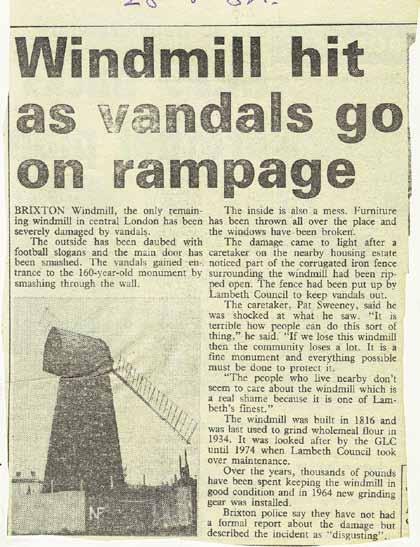
Lambeth Borough Council approached us late in 1984 and we agreed a schedule of works, after doing an inspection, starting in 1985...When we first went in there it was very run down and derelict – nobody had loved it for years...the first thing to do was to consolidate the top of the tower, which was in a mess. So we took the whole of the cap off – the sails, the cap. Were there any sails there? I can’t remember in 1985. There were. Yes, we took those off, brought them back here to the yard, and the cap, which was quite an operation coming through London. I remember taking it back when we’d finished it, middle of the night, high speed traffic escort by the police – great fun!

You know the machinery is a mixture – it’s a hybrid – don’t you? It’s machinery which has been brought to the mill from Lincolnshire, totally out of context...But you know I think that sort of thing if it’s recorded properly it’s OK. But...it gives a false picture because that machinery looks, for the London area compared to Lincolnshire... totally out of place. Maybe in the future that will be changed, I don’t know, but now it’s part of the history.
But then we had to rebuild part of the top of the tower. The brickwork was in a very bad condition. I remember doing some of that work myself with another guy. And we also replaced the curb ready for the cap. So the cap went back after about three or four months here in our workshops...
All quotes on these pages by David Nicholls David is a retired millwright who worked on the restoration of Brixton Windmill in 1985
In 1985 the windmill underwent major restoration. Millwright David Nicholls removed the cap, made new sails and repaired parts of the brick tower In May 1982 the South London Press reported serious vandalism at Brixton Windmill




I’ve lived in Brixton for a long time.
I’ve lived on the other side of the hill, so I didn’t really know the windmill until I started the Girls’ Brigade on the estate and then about ’84 [took] our little ones, five to eight year olds, up to see the windmill and we went up to the top and paid 10 pence a head…we had a picnic afterwards and made a real day of it. That’s when I really got to know and love the windmill.
June Stillman
After the 1985 restoration, June Stillman took younger members of the local group of the Girls’ Brigade to visit Brixton Windmill

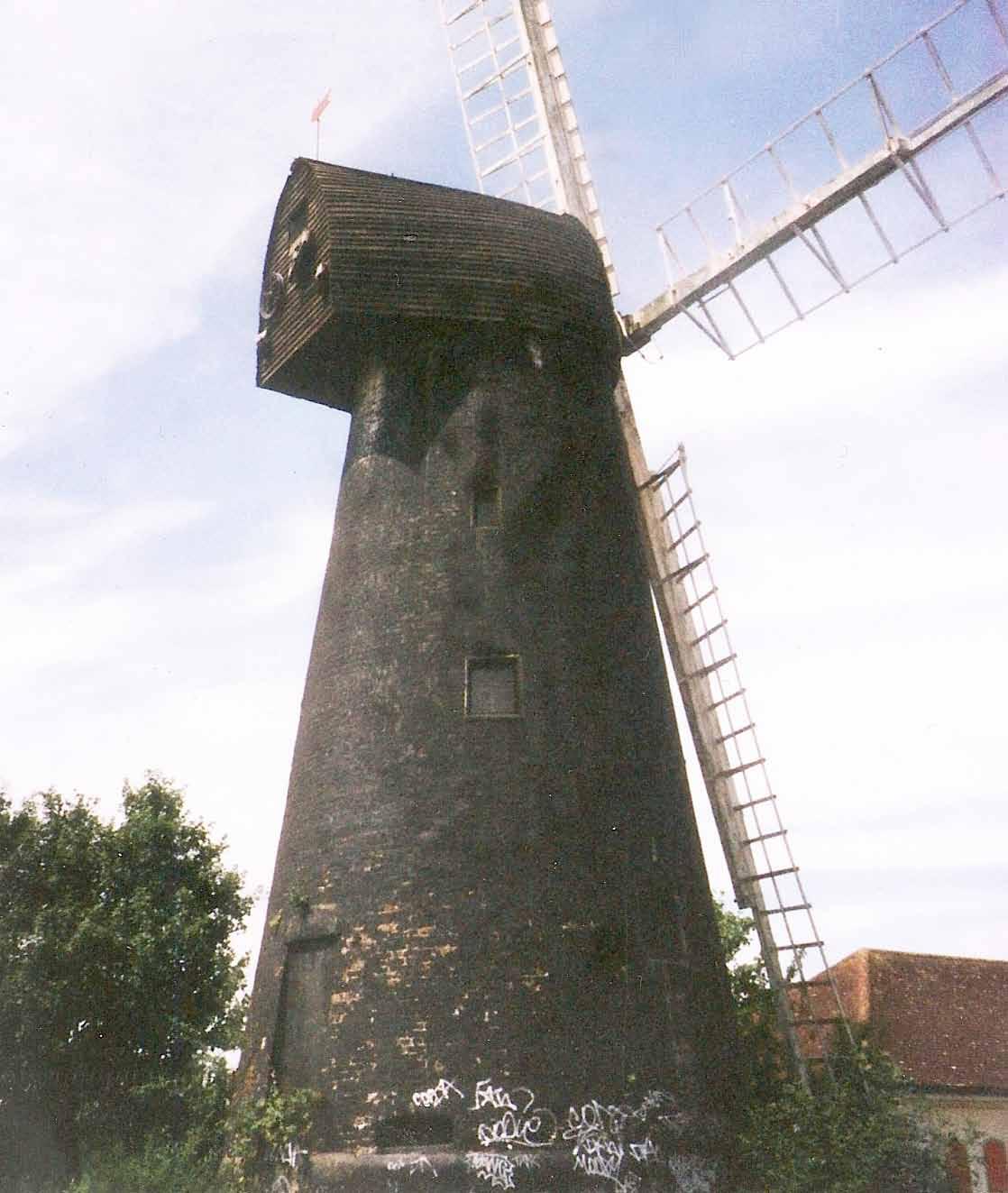
Another period of negleCt in the 1990s
Brixton Windmill falls into disrepair again.
I used to pass the windmill every day because I used to go to these drama sessions on Brixton Hill...and I remember looking at the windmill...and used to think ‘What an amazing-looking building, very unusual-looking building’ just because it stood out...It was only years later... that I passed the windmill and I saw this building in a really, really bad state, it looked very, very bad, bits falling off, there was graffiti everywhere, there were needles there, the park itself looked abandoned and the children’s playground also looked in a very, very bad way...And I stood there looking at the mill, and something touched me,
I was moved by seeing this building just abandoned and I thought that if we lose a building like this, we lose something in ourselves, as people, as a community.
Richard Santhiri Richard is a local resident of Brixton and was a driving force behind the campaign to restore Brixton Windmill and the establishment of FoWG


Iain Boulton At the time it was really not very salubrious because it had an old building beside it...it was being used for rough sleeping and there was a drug problem...and we sort of like went, let’s keep going through the park very quickly. But it was a really fascinating site, and we just said, look it would be really nice to put it into context and...how it had come to be here.

Magdalen Rubalcava Magdalen is a local resident of Brixton and has played a major role in Friends of Windmill Gardens and particularly in organising the summer festivals It was damp, it was dark, it was smelly, it was covered in bird droppings, dead pigeons, all sorts of things but it was utterly charming…And yes there was graffiti and all sorts of things but it was charming and I remember we often came here with our dog, and we just talked about it and what had ever happened. 32

I’d come in and I’d look at this windmill and I’d think, ‘Yeah, this thing looks good.’ Really. It wasn’t working then. It was only birds that was living in it. Pigeons! Everywhere you’d look there was a hole in, there was a hole and the blades wasn’t working. Over the year the blades, you’d get a little piece of the sail would drop off, yeah, and we went to pick them up and stick them in the sheds at Clapham Common, or wherever, yeah...nobody treated it with no respect or anything like that. It was just basically just a derelict building. Hector Marshalleck Hector used to be a team leader for Veolia and was responsible for maintaining Windmill Gardens
formAtion of fowg & eArly ACtivities In 2003 the Friends of Windmill Gardens were set up and organised a festival in the park.


One of the very first festivals that were held in the park was organised by Planet Earth...and it started off the tradition of us having regular festivals in the park...They spread lots of little toy windmills under the trees and they looked really good and they got students from Camberwell Art College to come and decorate the windmill with a great big sort of paper sunflower, which they hoisted up on the outside of the windmill and this transformed what was a very derelict building which always had in the past been suffering from graffiti and things like that, and made it sort of come to life, and gave us some inspiration about what could be done if you ran lots of good events in the park and could engage local people.
...money was assigned by the council after a lot of pressure from the Brixton Hill Working Group to be spent on projects in the Brixton Hill area, and we chose that it should be this consultation about the park and the windmill and that was done by a group called Planet Earth, a sort of consultation architect group... They got lots of different groups in the area involved, including particularly the residents of Blenheim Gardens Estate, the park shares a boundary wall with them...and it was after that that a group of residents got really excited about the prospect of improving the park and particularly restoring the windmill and the Friends of Windmill Gardens was eventually formed.
A field of toy windmills in Windmill Gardens at the final event of Planet Earth’s consultation with local residents about what should happen to the windmill and the park A giant paper sunflower made by students at Camberwell Art School being hoisted onto the windmill’s sails at the first festival in the park All quotes on these pages by Jean Kerrigan Jean is the current Chair of the Friends of Windmill Gardens – she has a view of Brixton Windmill from her flat


Jill Reyes organised flamenco dancers at the first Windmill Festival in 2003. They became a much-loved regular act at subsequent festivals organised by Friends of Windmill Gardens I think people can usually tell if there’s something dodgy about a project and this project was all of a piece, like the mill, a beautiful project which will carry on for generations and it was very much about inspiring, giving local people an opportunity to take part, to show their skills...this project is only the project it is because of the people who are part of it and make it work. Richard Santhiri
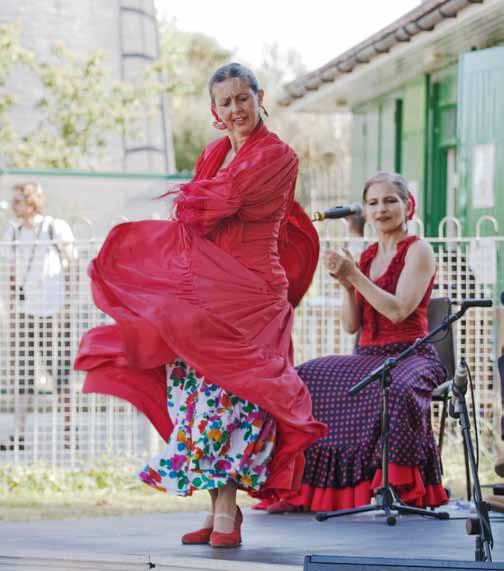
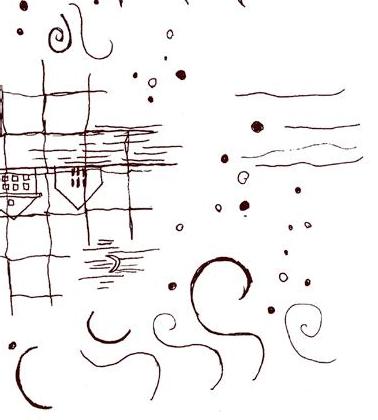
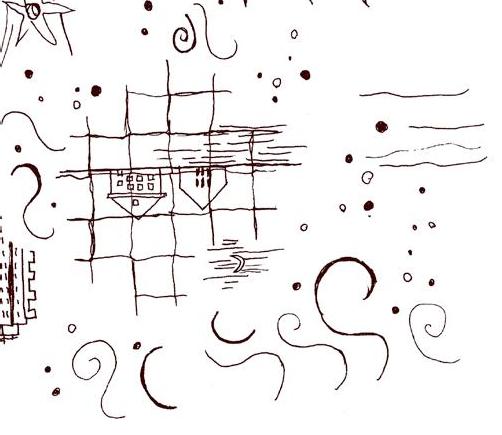
The very first one was just a flamenco group. The second one was where different people put different things in. It gave me the best opportunity...I was able to contact people who I had not had reason to contact for a very long time and to find out if they were interested in performing.
Both quotes by Jill Reyes Jill has lived in Brixton for nearly 40 years and is an active member of the Friends of Windmill Gardens ...the first main festival...was a bit panicky when people didn’t turn up from my point of view.
From that one we had Keith Hill, who was then the Member of Parliament, and he was a lovely man and the first thing he said when he stood up to open the event was: ‘I might be your MP,’ he very bravely said, ‘but I didn’t know I had a windmill in my constituency.’ And this was the case that not even the MP knew that the windmill existed.
Someone said, ‘Well why don’t we just try [opening up] the windmill [for open house]’, and Richard and Magdalen said, ‘It’s worth a try’. So we did it and of course you had the horrible metal door, I remember that and we had to open that, it creaked open, it was full of cobwebs, and hmmm, this is going to be interesting to get people in here and out. But we persevered, and I think it was about 2004, 2005 we actually did open house...and actually when we turned up that day there were queues of people, there was a huge queue of people waiting to get in. And it was busy, and we had the park rangers at the time and they were brilliant, they were really fantastic, they made sure that people were coming in safely...and it ran really well...People’s feedback was really brilliant...There were so many more people than we thought would come. We thought that they’d never come down Brixton Hill, but they did, and they did, and they did! Iain Boulton
Applying for money to restore the mill
In 2007 the Friends of Windmill Gardens set up a formal partnership with Lambeth Council and started applying to the Heritage Lottery Fund for money to restore Brixton Windmill.

Adrian Garden We did a presentation to the Heritage Lottery Fund and they said, ‘What a wonderful presentation you’ve made, how enthusiastic we are about what you’re trying to do’. But unfortunately at that point they were saying, ‘We’re all for restoring the windmill but it’s got to have more of a community draw.’... So they said, ‘Although you’re going to produce a wonderful restored windmill, which is of course of great historical and heritage interest you’re not giving them [the local community] that much. So go away, think about it again. We will give you someone to advise you. And come back with a bid more geared to, for instance, education.’ So we had a second bash...And we put together a bid that we presented just as I was fading away. And I think I was just still chair or just not chair when we actually heard we’d been awarded the several hundred thousand pounds...Well, that was really wonderful! Wearing his famed stove-pipe top hat, Adrian Garden, former Chair of FoWG, takes time out from performing with the Windmill Theatre Group to have a serious discussion with the local police at one of the summer festivals 38

Hector...was driving off in his van, I don’t know why he was there, and he suddenly saw this group of people and he knew something must be happening. There was a few Lottery Heritage people and it was interesting because one of them knew me and Richard from the theatre from a few years ago...Hector got out of his van, he was in his filthy dirty clothes and big rasta hair and he stood there and he said. ‘I don’t know who you are but I just want to say this is the most amazing project in the community and these people have worked really hard and we really need this project.’...I’m not saying it properly because I can’t remember but he was far more eloquent than the lot of us. Then afterward we went to the meeting in the council and the Lottery Heritage just said, ‘Who was that amazing man?’ and I mean you couldn’t have asked for anything more than that to happen and in a way I think
Magdalen Rubalcavahe helped clinch it!
In 2007 a formal partnership was set up between the Friends and the council. The council had always supplied workers to come along and help us and support us, and encourage us, and equally we were encouraging the council, you know, to take their responsibilities for this building, which is, after all, a Grade II* listed building, they own it, they have the duty of care for it...a number of applications were made to the Heritage Lottery Fund, I think it was three in all, and it was the last one that got the grant in March...2010, when we got the news that we had been awarded this substantial grant from the Heritage Lottery Fund...I think that the reason we got it in 2010 was because the Friends had worked so hard to engage the local community, and we could demonstrate that we had that support from the local community. Jean Kerrigan

Hector Marshalleck (second from right) with members of the grounds maintenance team in Windmill Gardens – firm supporters of Brixton Windmill
restorAtion in 2010-2011 The restoration took place October 2010 to August 2011.

Jean Kerrigan The restoration process...took place over a really difficult period. It was the winter of 2010-11, which you probably know was very, very cold and very, very difficult and probably not the best time to be restoring an old building like this, which was riddled with damp, and had all sorts of problems...It kicked off quite well and seemed to be going apace...The date set by the HLF advisers and so on was that it had to be completed by the spring of 2011, and yet work didn’t really start until the October of 2010, after the long torturous process of...putting in place the company that was going to carry out that work. Everything seemed to be going fine, the site was managed, it seemed to me very well, by a very nice young woman who was in charge of this site and seemed to cope very well, Ulrike. But towards the end of the process, partly because the weather conditions I think were really difficult, but obviously as we found out later, there were...financial problems with the company that had been appointed, work seemed to...drag out, and although it looked as if we were on target to get the building work finished in February, in good time to have a planned opening which we had set as the first May Bank Holiday...That all happened on May 7, but in reality the building wasn’t ready yet to be opened to the public, and it didn’t open to the public until the September.
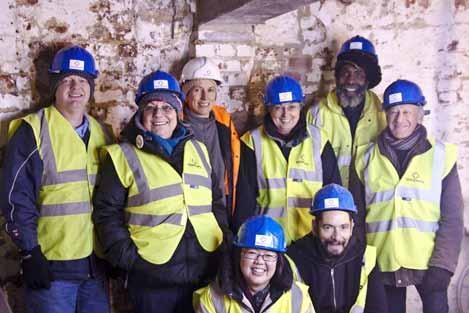
During one of the coldest winters of recent years Brixton Windmill without its sails or cap was wrapped in plastic as restoration work went ahead Kim Winter Kim has lived in Brixton for 27 years and leads the communications group of the Friends of Windmill Gardens I...suggested – because I’m a journalist...that it would be good to set up a blog to record the progress of the restoration. People seemed to think this was a good idea. I was expecting to have to get the idea approved or go through various committees or whatever. But it wasn’t like that. They just said fine go off and do it…I set up a WordPress blog and the restoration started at the end of October. I just got used to popping along once or twice a week. I got very friendly with Ulrike from Stonewest who was managing the project and I used to come and have a chat with her. She’d tell me what had been going on and I used to get Owen to come and take some photos and we just started recording the blog and I got very friendly with Ulrike. It was a freezing cold winter and I remember coming across and she’d be huddling over her tea cursing the weather – because of the hold ups. If it was too cold they could not work on the brickwork and so on. I even had to bring some de-icing fluid over at one stage because the container where they kept all their tools – the lock had frozen so they could not unlock it.

...the first thing we had to do was get the sails off. We craned those off and we brought them back here to our workshops where we stripped them down, repainted, repaired and made a set of shutters for the patent sail frames. Once the scaffolding was up, the main contractor on the site had stripped the cladding off the cap. We looked at the mechanics of the cap turning mechanism. We repaired it where it was needed, we lifted the cap up to check that the skid plates that are sitting underneath the cap frame on top of the curb were in good order. Whilst we did that we lubricated the cap, also the cog ring and everything that’s on the curb. Once it was re-clad, it was ensuring that the cap would turn. I don’t think the cap had turned for an awful long time and we managed, we got it turning again. We did all sorts of bits and pieces to make sure that it would work and it’s starting now a year, two years down the line, we do it fairly regularly and it’s beginning to work quite well.Well, the cap at Ashby’s Mill in Brixton, the turning mechanism that’s there now, was
brought down from a Lincolnshire mill, so there’s, like, an internal cog ring on the curb with a pinion drive. There’s a wheel on the outside of the cap which potentially a chain or a rope, a continuous chain or rope could go into it, and as you pull the rope down it turns all the mechanism to turn the cap around, it pulls itself around the curb.
The cap housing the shaft and the brake wheel was completely stripped down during the 2010-11 restoration
Millwright Paul Sellwood takes the sails off to check and repair them at his workshop near Reading ...the most common sails that people would associate with windmill sails are the, what we would call common sails where a huge sailcloth, effectively like a big curtain, is pulled across the sail frame and tied on. Each sail would have been pulled round, the miller, whoever, would have pulled, unfurled the sailcloth and each time, then, obviously, they would mill, use the wind then for that day. The next style of shutters are what we call the patent style of shutters which are operated by either a rocking lever or a rack and pinion sort of wheel, again an endless chain which would hang down the back of the mill whereby the rod, the striking rod as it’s called, passes through the windshaft out to a ‘spider’ with various linkages which go to all four sails so, as you operate it, it closes off the shutters on all four sails at one time. The spring system, each individual sail has an elliptical leaf spring fixed to the top of the sail frame and then a long rod which passes right down to the bottom whereby the various bits are connected to what we call the working up longs and the system we’ve designed for Brixton was that the shutters would close by winding a screw thread to a stop lock so as the shutters closed, fully closed, they’d hit the stop lock. Keep winding and you close the leaf spring. Now, as the wind blows, you might get gusts of wind, as you get gusts of wind it blows against the shutters, and then the shutters will just slightly open - it’s what we call spilling the wind. Of course, the tension in these springs, the shutters would close again during the rotation.

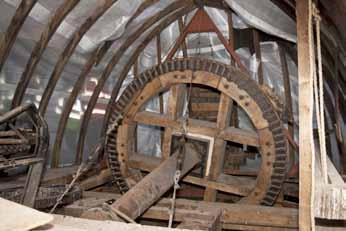

On the monthly visits, what we do is we turn the sails, we do that every month just to throw off any standing water and that maybe sitting in the joints. We operate the shutters, make sure the whole mechanism works, we check all the bolts, the clamps, we lubricate the neck bearing, the tail bearing and any other moving parts of the mill. On the quarterly, every three months, we go through the whole process again and we also lubricate and rotate the cap a full three-sixty just to ensure that everything is working as it should.
...it is incredibly hard work, it really is hard work. We have tried to count how many rotations of the hand winding handle it takes to do a complete rotation and I think half way round we give up because we’re so out of breath. It is getting easier as time goes on, the more more we lubricate, the more we do it, it is becoming easier, I say because many years ago the cap just didn’t turn, it was a static cap, so it is working, it’s getting much better now.
All quotes on these pages by Paul Sellwood
mAy dAy pArAde 2011The Friends organised a big festival and parade on May Day bank holiday 2011 to celebrate the restoration of the mill.

Henry Ashby When it was opened I came down here and was asked to cut the tape as I was one of the descendants of John Ashby. It was a very enjoyable day here. We had the Lady Mayoress of Lambeth, and your local MP – very clever person indeed, I must say. Very enjoyable. And to see the enthusiasm that the mill generated and you had a group of actors who acted the history of the mill – quite fascinating.

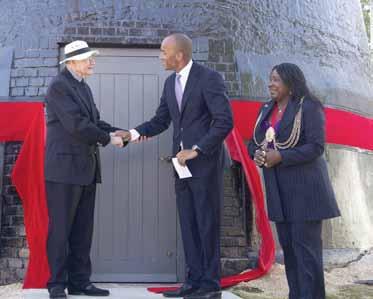
Henry Ashby, descendant of Brixton Windmill’s first miller John Ashby, shakes hands with local MP Chuka Umunna after formally opening the restored building on 2 May 2011. Lambeth’s Mayor looks on Amazing hats, stunning costumes, happy people came out to celebrate the reopening of Brixton’s much-loved windmill
Some of the 2,000 people who joined the parade from Brixton town centre to Windmill Gardens
45 Kim Winter The opening day was amazing. We decided to have the summer festival, which is normally later in the summer, to bring it forward to coincide with the opening and have a parade up Brixton Hill from Windrush Square to the windmill. Magdalen, who organised it, is an extraordinary character…I just remember what seemed like hundreds and hundreds of people walking up Brixton Hill in a long procession and looking back and seeing this endless parade of people. We were standing in Windrush Square at 12.30 and the parade was due to leave at one and Magdalen was saying: ‘There’s only 20 people here – nobody’s going to turn up,’ and we were all panicking and thinking all this publicity and we tried to get people interested and enthusiastic and it’s not going to work. And then suddenly, at one o’clock, the multitudes appeared. It was fantastic! It was a lovely sunny day and I look back at the photos, people dressed up; the women in their fancy hats, people carrying placards, everyone smiling, laughing and enjoying the festivities...I think it was then that made me think: this is a great community group to be involved with. It really succeeds in bringing people together around the windmill. 45
importAnCe of flour& BreAd produCtionBread and flour production are important in many cultures around the world.


...we need to do a feasibility to study, to see if the building can sustain regular grinding of flour. Not using the wind power, because that would never work, the wind power machinery is not the original machinery, but we have got the machine that the Ashby family...we’ve got their mill which was driven originally by steam engine, then by gas and now has an electric motor on and was fully restored during the last restoration. We’ve got that piece of equipment, that pair of stones...it can grind flour. The question is, can it grind flour regularly and not endanger the fabric of the building and we are currently raising a fund to do a feasibility study on that...If it proves possible to run that regularly and grind flour regularly then that might be a way of bringing in some income, but it won’t be enough I don’t think, ever, to fund a full-time education programme.
Jean Kerrigan
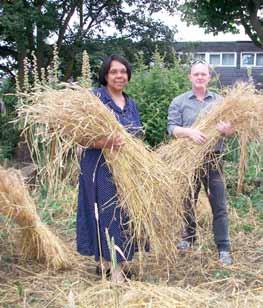

...so I took over the allotment and it did cross my mind that if I was able to grow wheat I could take it to the windmill, not realising that it was no longer working. But I could make the flour, grind the flour and make the bread out of that!

Each year since the windmill reopened in 2011 the Friends have grown and harvested heritage wheat in Windmill Gardens It all began some years after the war because we always had that grey national loaf. Then they changed to the sliced white bread which I regarded as horrible. And one day...I thought I could have a go at making my own bread, which I tried. I think the majority of people when they first make bread are a little impatient and they don’t let it rise fully. So I made it, two little loaves, they went in as two little loaves and they came out the same size. One of them was so disgusting I threw out into the gutter and even the birds didn’t eat it. That particular weekend, as a special treat I made this bread for two friends who came down from Birmingham. They had been in the navy – and you can talk about hard tack – it wasn’t in it! So, they were going over to Germany because they’d both been in the fire service. One of them complained – he said: ‘What a wicked waste to throw bread away’ and I said, ‘If you still want it I’ve got one you can take with you.’ A couple of days later I had a postcard saying, ‘We arrived in Germany in good time and we had a good crossing, unfortunately the bread went Both quotes on this page by Robert Burns over the side halfway across the channel. There was no way we could get our teeth into it!’

When I was about six, seven we used to collect wheat from far away from where we lived – my parents inherited some land – and we used to collect the harvest once a year – specially wheat and barley at the end of September. End of August and September, I went with my mother…we shared it with the people who cultivated the land.

Unfortunately it was the time when we had rationing in Spain. After the war everything was scarce, especially the basic things: flour, rice, oil, lentils, chickpeas, things which are the basic food of every days...It was forbidden to hold or have in your house if you were a farmer more than you need so the government would confiscate, pay you little money for it, confiscate the grain to produce bread and flour for the nation. So my mother, collecting these bags of wheat, had to do it clandestinely.

To take the grain to the mill, to the windmill, it was more or less the same question. You would not like to be discovered you had in your hands a few bags of flour. The policeman would ask you where you got that flour from. Therefore you had to hide that flour…In order to transport the bags to the windmill a neighbour had a wheelbarrow, wooden wheelbarrow, but it had a double bottom, a double layer, sort of cover where you could hide a few bags of flour…So my elder brother who was about 10 or 11 years older than I was – I was about six or seven – so he would put the bags in this camouflaged wheelbarrow thing. A couple of planks of wood on top and then I would sit on those planks of wood pretending he was taking me on the wheelbarrow...My mother used to put a bandage on one of my ankles to pretend that I couldn’t walk.
It was a lovely feeling to be inside the mill. I remember the miller – always I saw him white. Covered in a thin coat of flour. His moustache was white, his eyebrows were white, his eyelids were white – even his overalls. I don’t know how he managed. He always looked to me like a white man, like a snowman, a walking snowman. It was a very busy place...At the back of the mill he had his own bakery – a small bakery in which he baked bread for the neighbours and so on and his family. It was lovely to be there. Sometimes a whiff from the oven. A whiff of fresh bread from the bakers. It was like a whiff from heaven.
All quotes on these pages by Julio Varela
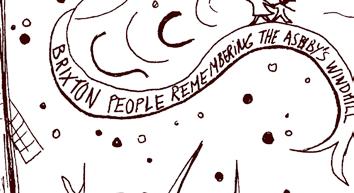
In Turkey bread is a crucial part of our meals like breakfast, lunch, and dinner. I don’t know any Turkish person who eats any of these without at least a slice of bread next to it. And it’s usually white Turkish, crusty, type of bread. Which usually is very fresh, is never preserved or anything for the next day. It’s usually baked fresh from the oven – really nice crusty, beautiful Turkish bread.

… my favourite, really nice crust. I’m finding it difficult to find the right English word for it. Really nice…it used to have a long edge – that white bread – which had a really nice crust – slightly burned – not burned but kind of over baked because it was the edge. I used to just – like a mouse – peel that bit off and eat that part first. It’s really nice and like a cottony soft – but a hard texture, a hardish kind of texture not as soft as cotton inside, and really nice crust outside. And the smell of it – my God – with a little bit of butter!… it’s the most amazing thing…I could eat half a whole loaf of bread like that.

We have the normal loaf. We have the pide, which is a flatter type of bread…about an inch…It’s that thick and quite big and you can either…tear it or cut it in neat squares – whatever you do, you just want to start eating it straight away. It’s such a nice bread. Because of bread, cheese is also very important. Because we have such nice bread you have to eat it with something right? You eat it with cheese. If it’s summer you have melons or watermelons next to it as well so bread, cheese, especially feta cheese, to go with it and watermelon – together with Turkish tea is a perfect summer light tea or dinner.
And also we have simit, which is very traditional but not as nice as they used to be when I was a child – this round kind of bread but you can eat it on its own and it’s dipped in so many…dipped in sesame seeds – really nice and crusty outside, and soft and kind of bagely-tasting inside – really nice to go with tea again.
…so many women can actually bake bread and their parents know how to even make the flour in between two stones. Because our parents are aware of it they usually talk about it, they can bake. And my mum could bake brilliant stuff...We even used the bakeries. Like my mum used to prepare the dough for bread, for porcha, for numberey, for pastry dishes, and send it to the oven of the bakery to bake what she made – in exchange for an amount of money. Because they had better, nicer ovens – we could actually use their ovens – kind of rent their ovens. Ozgur Tasci enjoys eating traditional Turkish breads And also you’re going to eat more of it. That’s why we have big bellies in Turkey! The cost of eating it. You know my father used to go to the bakery early in the morning, buy me a really nice loaf of bread – just for me – still warm. I used to cut it in half and he used to put butter inside it for me for breakfast and I would start my day with half a loaf of warm Turkish bread with butter.
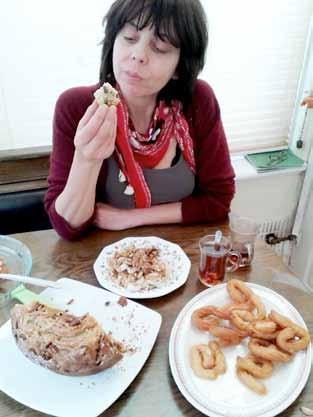
All quotes on these pages are by Ozgur Tasci Ozgur is a local resident of Brixton She grew up in Istanbul, Turkey



The Old Post Office Bakery are firm supporters of Brixton Windmill, making gingerbread windmills for our summer events Well hopefully it will come to the point where we genuinely are able to produce bread, maybe not only the Windmill Loaf, that has been milled at the windmill. I’ve already started to connect with local schools and have school children coming in and look at the bakery and understand about food and food production in the way that we do it. I think...from what I understand the idea is to make the windmill into a sort of educational centre in the same way. To really teach the kids again about the importance of how food is produced and nutrition and eating and all those things. Perhaps parties of kids can look at the windmill and can see how flour is produced and then come and see how it’s made into bread and other things for us to eat. Someone said: ‘Shouldn’t we make a windmill loaf? Isn’t that the obvious thing?’ So it seemed because we have had this long association with the windmill group and we have always been making stuff for the festivals we thought wouldn’t it be great if we could actually make a windmill loaf from the flour ground in the local windmill. And so somebody said, ‘Well – yeah. Let’s call it the Windmill Loaf!’…So within this loaf we are using the magister wheat – locally grown...We’re cutting it in a way that is supposed to sort of reflect the sails on a windmill. So we are doing these little cuts around the edges so that it has a sort of ‘triangularish’ shape. Four triangular type things. [Laughs] It doesn’t look exactly like a windmill I have to say but that was the idea behind the cuts anyway. We are going to donate 40p from the sale of every loaf towards the renovation of the windmill and getting it into being a mill again...And then we’re using the sourdough process to rise it and we’re baking it on the floor of the oven.
One of the first organic bakeries in London, the Old Post Office Bakery now sell a special windmill loaf made using locally grown magister wheat: 40p from each sale goes to Brixton Windmill to help it start grinding flour again All quotes on this page by Richard Scroggs Richard runs the Old Post Office Bakery and is a longstanding supporter of Brixton Windmill
Bringing the Community together


Richard Santhiri I just think that this is a very unique building in a unique place, because Brixton is a unique area from the point of view that there are so many different cultures here, and the mill is a beautiful building, it relates to the whole world because it uses grain which all cultures do, and I think that people can see the type of work that the Friends do which is really vital and important in not only keeping this mill going but also in inspiring the community and educating new generations about their local history and about a kind of spirit, I think a community spirit, that we have lost, which this project is very much trying to build and bring people together, partly because people come to areas, stay in areas for maybe a few weeks, a few months, and leave, so it’s nice that the mill at the top of the hill is advocating this. How Brixton Windmill acts as a constant focal point in a community that is constantly changing.
National Mills Weekend, we had [the sails] turning for the visitors virtually all day and it was the most amazing sight. And I get quite a buzz knowing it’s something I’ve worked on and lots of people coming to see and it’s working. I’ve had so many people come to me and say, ‘I’ve lived in Brixton virtually all my life and I’ve never seen this happen’, and as I say it’s very, very pleasing, very satisfying. Paul Sellwood
Windmill Theatre Group perform a play about the history of Brixton Windmill at our summer festivals
The Friends organise a five-a-side football competition each year in Windmill Gardens I think [the restoration] is important for the area. The fact that people living in Brixton - I mean Sue comes from
Lambeth, I come from the other side of London but nevertheless - neither place has the best reputation. But there are good areas of Lambeth and it’s good for people to latch onto the fact there used to be a windmill here, there used to be a little village, it has a history to it and a life, and for people growing up to realise how flour was milled and how the structure of a windmill is quite intricate. It’s not just a piece of wood that spins round and grinds - it’s very very cleverly made.
Each year our Art in the Park event encourages artists of all ages and abilities to draw and paint Brixton Windmill
Gilbert Young
...There is an electric motor up there, which I believe will be used in order to run it. Now that’s fine and that will be great and that will get it going. But it’s also very important that the young people should know about the sails and about the steam engine and that part of it. So they know how it used to be.
The other thing is that youngsters when they grow up will probably be at some stage in school. They’ll see pictures of these windmills and they’ll probably think to themselves, ‘Well, I’ll never have a chance to see one of those actually operating’. But they can come
Both quotes above by John Thorpehere and here it is! Throughout the summer, volunteer guides trained by the Friends lead groups of visitors on free tours of Brixton Windmill

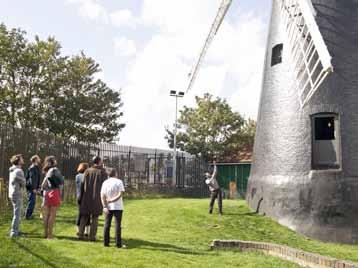



...the best thing about it has been having been able to be reunited with people I wanted to rediscover – people from the past who – musicians who maybe weren’t given the opportunity to play. People who have been wonderful musicians but have rather given up over the years… And given them the opportunity to have a place to perform, where they won’t make any money out of it, they didn’t do it for the money – in fact they’d be lucky to get their bus fares paid – but the joy of getting people together – and this takes quite some planning.Jill Reyes When you work in those surroundings [Brixton Prison] with very disturbed and people who have been less fortunate than myself, you look for something that can bring the outside into their lives, especially the people in there that suffer from mental illnesses. So the windmill was always something I kept as a secret...I told them...there’s a lovely football pitch and there’s a nice exercise yard and there’s a nice library but then as the time came I said, look, there’s a real gem but you’ve got to work your way to a certain wing to get there. Cos there’s only a certain wing that you can see this windmill really and truly at its best. So we used that for conversation to get people’s attention, to get them away from thinking about other stuff which sometimes was suicide or leaving their families or even just finding themselves somewhere, not just in a prison. They were in a prison with a view to a windmill. So as the time went on some of the guys in there wrote poetry - love poetry around the windmill - so you’d see them slipping off and going up to the window and writing the stuff. We’ve had artists and above all we’ve had people who lived for to see that windmill every day, every day. And that to me prevented something worse happening in their lives...Some of them drew the windmill in its glory. I’m trying to find those pieces of art - you know the blues and the greys and the sails were bright and they had a story behind it...In those days it looked a bit dilapidated and now it’s becoming more like those pictures: it’s greyer, it’s brighter. Obviously we didn’t know what the inside was like...It was all around getting themselves inside the windmill instead of being in their own mind at that particular time. So they were thinking what the windmill could be used for and some of them even had ideas of, you know, when they got out they were going to find more about the windmill. Growing vegetables and wheat was a big thing - they wanted to see this windmill working again. I was delighted, because at the end of the day, this is Brixton...right...people who don’t get nothing come from Brixton. There’s been a lot of negative press about Brixton, right, forgetting all the good things and all the good people that’s come out of here, so something like this, in Brixton, is positive and everybody’s got to see it, it’s not just the selected few, everybody sees it and everybody knows about the windmill. So the heritage of Brixton is good. You don’t find many of these round about the country, not like this, this is original. So, you know it’s good. And I mean for the local kids it’s part of their heritage really. They can come in here and they can see how this work was done so many years ago, and how they used to get their bread.
Local children get creative, making masks at one of our summer events
In some respect it’s a shame it’s stopped working and no one can understand. For the next lot of generation growing up it would be quite interesting to see how some of these things work, especially boys or girls, they’re that educated they want That guy was as good as gold. I couldn’t have done it. He was sat in that pie for hours! That man was sat in the pie for hours. While I was marking the four lanes down here so they could have a sack race, this man was already in the pie. He was already sitting there with his pigeons or whatever. And this must have been about half past 10, 11 o’clock in the morning. So when I got to Brixton, to Somerleyton, this man was still in the pie. But while they was doing everything, while they was decorating, this man was still in the pie and I couldn’t believe that this man...I didn’t even know this man was in the pie. It was only when I was asking them when are they going to get this thing in this pigeon pie and they said no this man’s in the pie, he’s already been in there a couple of hours. So anyway the parade’s going on, it’s already taken about an hour to get from the police station to up here, or it could have been longer, and he’s released the pigeons at Brixton. But he’s still in the pie! We’re driving along back to the yard to take these things off and we stopped at the lights and I hear a bang! So I looked round and there’s a panel, the panel’s been kicked out and it’s dropped in the road! And I looked and I see this man standing there and he wasn’t very happy about being stuck in this pie! But then none of us knew he was still in this pie! The man must have spent at least four and a half hours sitting on one chair in to take an interest in them, how this pie. Both quotes above by mechanic things work. Hector Marshalleck
Janet Hayes Janet grew up in the area around Brixton Windmill in the 1940s and 50s 57 The 2013 parade included a float with a wooden ‘pigeon pie’, containing a man who released real pigeons. Hector Marshalleck describes what happened. 57

the future
What next for Brixton Windmill?





I think it needs to be a mill village, an agricultural village. You know how when you’re children, you go out and you visit so and so’s something. Well that’s what you can do, but the more people you put in, then I’m convinced Thames Water will become involved and if you know that around the corner that’s a pump house, it’s a beautiful pump house but you can add to that so Richard Santhiri ...I believe the windmill is a teacher of a type, it’s much older than all of us and it’s a wonderment, it’s a magic, it’s an inspiration, and I think that the more that we look at the mill the more we can dream, and out of dreams are born reality for all creative people and people who understand dreaming that you need to have some type of concept, some type of hope, some type of dream in order to manifest that. As the Friends we have started the process in manifesting that and we are also educating the new generation and young people about this building, what it used to do, what it can do and I believe what goes around comes around. The mill is a rounded building and our way of thinking is quite rounded, quite complete, and certainly all the artists who are part of Friends of Windmill Gardens and the people seem very rounded individuals, people who actually want something which is far bigger than thenselves; they see a community, they see generations to come and we are all playing a part, and I would like to say a really important part, in the future of this building. We need to make an appeal to companies, education trusts, grant-giving funds who are people can see that. It’s all interconnected.Magdalen Rubalcava interested in maintaining the heritage of this country. This is a unique building, it sits in one of the most densely populated inner London boroughs and yet it’s a symbol of a rural past that certainly existed; and that is what we are going to have to try and inspire people with in Jean Kerriganorder to raise the money for its future. 58






There was a joke once, and I think, we all had a joke once which said wouldn’t it be great to actually make more of the windmill, if we could put it on wheels and we could push it all the way to Clapham and plonk it in the middle of Clapham Common, because there’s a Windmill Drive, there’s a Windmill pub, here’s the windmill. And that was a bit of a joke and I thought if we said that too loudly someone’s going to give us a smack on the wrists. But it’s about selling it, it’s about presenting it more, selling it more...It’s about realising it is surrounded by buildings, but it’s actually getting people to be drawn in more, and I think that’s the big drive for the next 20 years is to keep it looking good, improve the gardens around it so its context is better, but also to get more people coming in and realising...You’ve got a massive housing estate here, the Blenheim Gardens Estate, and you do sometimes wonder how many people on the estate realise that the windmill is here.
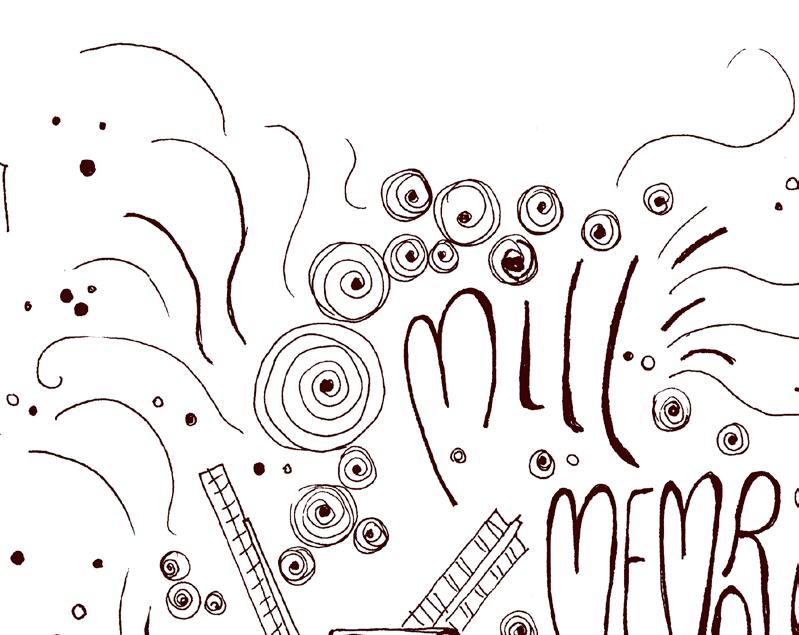

One thing that’s interesting is that I think it’s about its context within London, because there are windmills in the rest of London. Wimbledon Common’s got a windmill and there’s a windmill in Reigate...and I think it’s about, almost a map saying these are where they are across Greater London and the surroundings. Because people are fascinated about how humans have come to use things like wind power and water power to generate the energy and the things they need in the past. People are fascinated about how, you know, we’ve exploited the environment to actually produce what we want. And I think it’s about keeping the windmill and the gardens in context with other sites around Greater London, and I think a map or some sort of project around that would be brilliant. Not just wind power, I think also water power, because people are starting rediscovering, you know, you’ve got wind turbines and solar panels, ground heat pumps and people are really starting to get passionate about using the environment to generate energy, and I think you can say, well, we’ve been doing it for over 200 years and this is an example.

Both quotes above by Iain Boulton
How do I see the future? It all depends on people. It depends on, you know, who is leading the team to ensure that the mill has as good a future as it can do. This is the key factor actually. I mean we’ve been involved with mills over the years from one local authority. They change the officer in charge, it goes flat, somebody else comes in with grand ideas, it starts up again, it goes flat, this happens time and time again. And that’s no way to present. So the answer really is having a key team of volunteers and preferably a windmill trust. That’s the key to it all.
David Nicholls
We don’t have a lot in Lambeth, let’s look after the bit we’ve got. And we’ve got the windmill. June Stillman

Star trails above Brixton Windmill
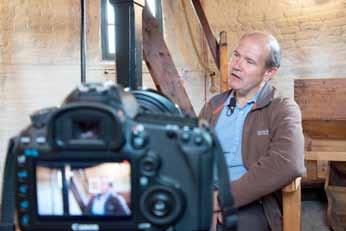

thAnk you
We are enormously grateful to everyone who contributed their time and skills to the Mill Memories project, and to the Heritage Lottery Fund for funding.
interviewees Henry Ashby Iain Boulton Adrian Garden Songul Guler Janet Hayes Jean Kerrigan Hector Marshalleck David Nicholls Magdalen Rubalcava Kate Quigley Ruby Richard Santhiri Richard Scroggs June Stillman Ozgur Tasci Julio Varela Viv Whittingham Robert Burns Florence Hall Maureen Lemon Jill Reyes Hatice Sami Paul Sellwood John Thorpe Kim Winter Gilbert Young Susan Young interviewers Dee Byrne Mike Loosley Jean Kerrigan Sarah Lowry Ann Lee Anna Sweet Dilana Tasci Kim Winter
proJect mAnAger Sarah Lowry photogrAphy/recording Owen Llewellyn Clapham Film Unit picture reseArch Jean Kerrigan Penny Steele design Pansy Aung illustrAtion Elena Blanco dreamyme.com


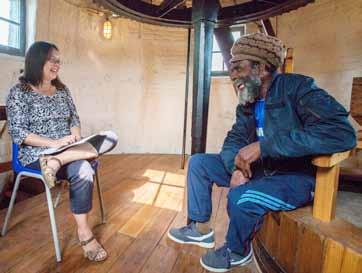
picture credits Owen Llewellyn (FoWG): pages 7, 8, 13, 16, 36, 38, 39, 41, 42, 44, 44-45, 45, 52, 54, 55, 56, 57, 59, 61, 62, 63 The Miller: page 10 Mills Archive Trust:: page 15 Mills Archive Trust / M T Mason Collection: Girl at Brixton Windmill; Brixton Windmill working with sails: pages 14-15, 15Brixton Society / Bill Linskey Collection: pages 18-19, 22, 23Maureen Lemon: page 20 London Borough of Lambeth, Archives Department: pages 19, 21, 23, 25Richard Santhiri (FoWG): page 26-27 South London Press cutting 29 May 1982: page 27June Stillman (FoWG): pages 28-29, 31Penny Steele (FoWG): pages 34-35, 35Jean Kerrigan (FoWG): pages 46, 47Dilana Tasci: page 51 Pansy Aung (FoWG): pages 52, 52-53



brixtonwindmill.org brixtonwindmill /brixtonwindmill

